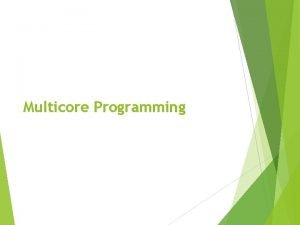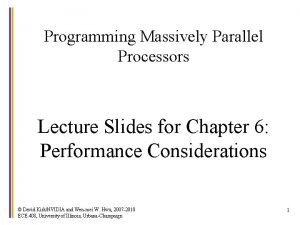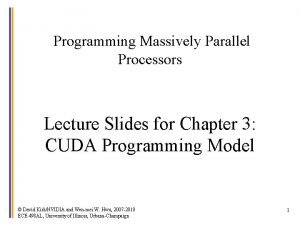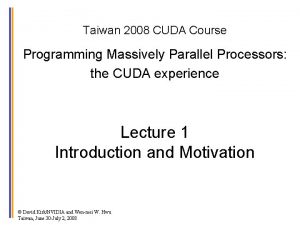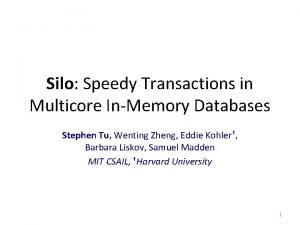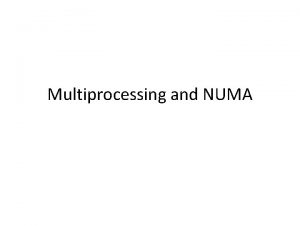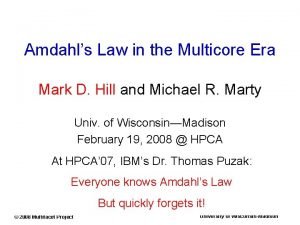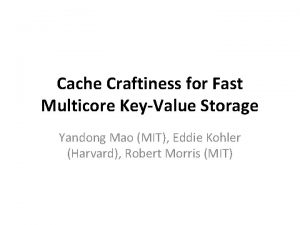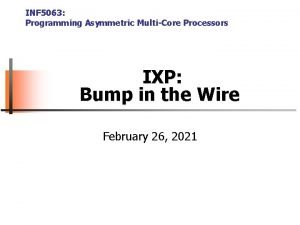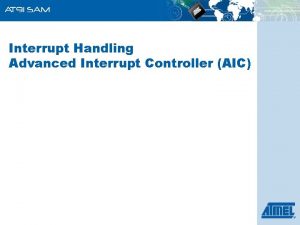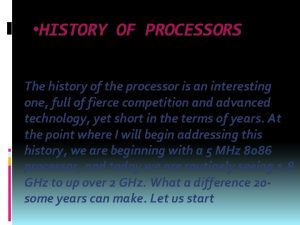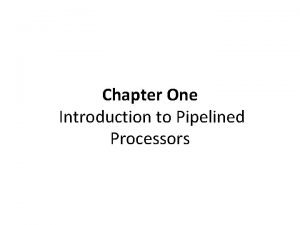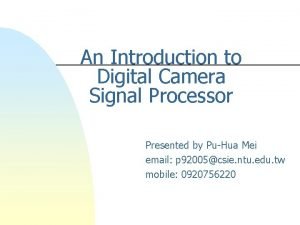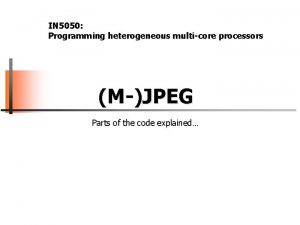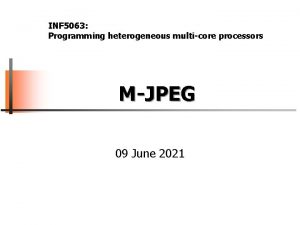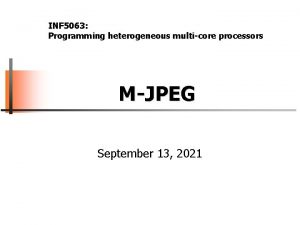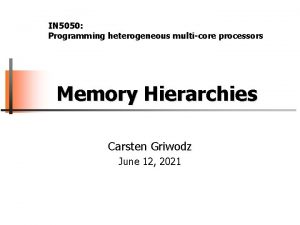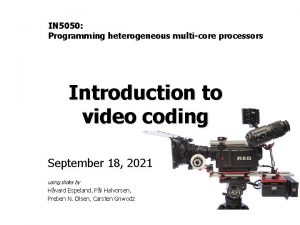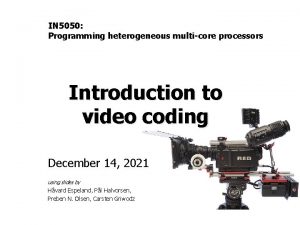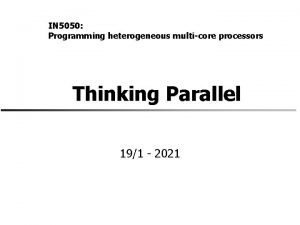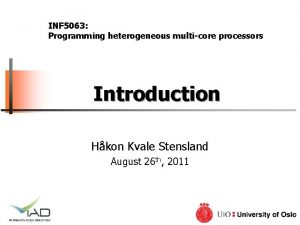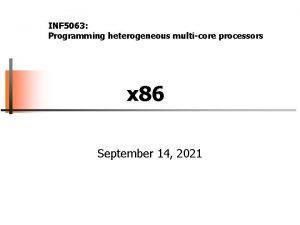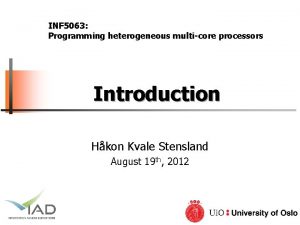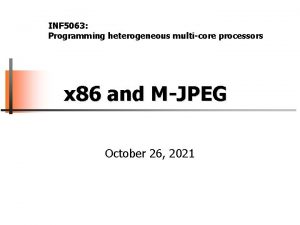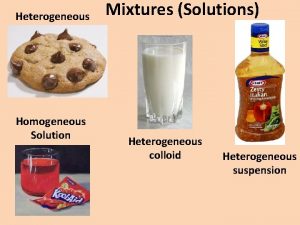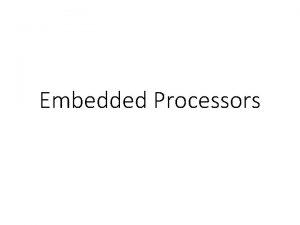IN 5050 Programming heterogeneous multicore processors MJPEG Parts




















- Slides: 20

IN 5050: Programming heterogeneous multi-core processors (M-)JPEG Parts of the code explained… January 4, 2022

Why ? Hmmmm… IN 5050 is about programming heterogeneous multi-core processors. Why video coding? We want to look at parallelism that is required for everyday tasks… According to Cisco in 2016, Internet video will in 2017 globally … § have a compound annual growth rate of 30% § reach 62. 7 Exabytes per month with 69% of Internet traffic § have 2 trillion minutes (5 million years) of video content crossing the Internet each month. That's 914, 100 minutes of video every second streamed or downloaded … § Many of the video codec applications are time-critical § A codec can become memory-bound, CPU-bound, IO-bound opportunities for both data and execution parallelism AND real-world relevant (Today, we define a video as a sequence of still images – (M)JPEG, more next time) University of Oslo IN 5050

Data Compression The human eye − is good at seeing small differences in brightness over a large area − not so good at distinguishing the exact strength of a high frequency brightness variation can reduce the amount of information in the high frequency components University of Oslo IN 5050

Data Compression § Alternative description of data requiring less storage and bandwidth Uncompressed: 1 Mbyte Compressed (JPEG): 50 Kbyte (20: 1) . . . while, for example, a 20 Megapixel camera creates 6016 x 4000 images, in 8 -bit RGB that makes more than 72 uncompressed Mbytes per image University of Oslo IN 5050

1 - Split each picture in 8 x 8 blocks § Each sub-picture is divided into 8 x 8 blocks, number depends on resolution University of Oslo IN 5050

2 - Discrete cosine transform (DCT) § Each 8× 8 block is converted to a frequency-domain representation, using a normalized, two-dimensional DCT University of Oslo IN 5050

2 - Discrete cosine transform (DCT) § Each 8× 8 block is converted to a frequency-domain representation, using a normalized, two-dimensional DCT − each pixel is represented by a [0, 255]-value − each pixel is transformed to a [-128, 127]-value University of Oslo IN 5050

2 - Discrete cosine transform (DCT) § Each 8× 8 block is converted to a frequency-domain representation, using a normalized, two-dimensional DCT − two-dimensional DCT: − Gu, v is the DCT at coordinates (u, v) − u is the horizontal spatial frequency [0, 8> − v is the vertical spatial frequency [0, 8> − gx, y is the pixel value at coordinates (x, y) − α is a normalizing function: Note the rather large value of the top-left corner (DC coefficient). The remaining 63 are AC coefficients. The advantage of the DCT is its tendency to aggregate most of the signal in one corner of the result, as may be seen above. Compression possible: the following quantization step accentuates this effect while simultaneously reducing the overall size of the DCT coefficients University of Oslo IN 5050

3 - Quantization § The human eye − is good at seeing small differences in brightness over a large area − not so good at distinguishing the exact strength of a high frequency brightness variation − can reduce the amount of information in the high frequency components − simply dividing each component in the frequency domain by a known constant for that component, and then rounding to the nearest integer: where Qj, k is a quantization matrix, e. g. , for JPEG G 0, 0 = -415 Q 0, 0 = 16 University of Oslo = -25. 9375000000 ≈ -26 IN 5050

4 - Lossless compression § The resulting data for all 8× 8 blocks is further compressed with a loss-less algorithm: − organizing numbers in a zigzag pattern: -26, -3, 0, -3, -2, -6, 2, -4, 1, 1, 5, 1, 2, -1, 1, -1, 2, 0, 0, 0, -1, 0 , 0, 0, … , 0, 0 − Compress using for example run-length or Huffman coding University of Oslo IN 5050

JPEG Encoder Overview Prepare (RGB 2 YUV) Fn (current) DCT Encoding: University of Oslo IN 5050 Quant Entropy coding

DCT / Quantization // Make 8 x 8 block of the entire picture for(y = 0; y < height; y += 8) { for(x = 0; x < width; x += 8) { … //Loop through all elements of the block for(u = 0; u < 8; ++u) { for(v = 0; v < 8; ++v) { for(j = 0; j < jj; ++j) // Inner DCT for(i = 0; i < ii; ++i) { // Inner sum of DCT float coeff = in_data[(y+j)*width+(x+i)] - 128. 0 f; dct += coeff * (float) (cos(…) * cos(…)); } float a 1 = !u ? ISQRT 2 : 1. 0 f; float a 2 = !v ? ISQRT 2 : 1. 0 f; /* Scale according to normalizing function */ dct *= a 1*a 2/4. 0 f; /* Quantization */ out_data[…] = (int 16_t)(floor(0. 5 f + dct / (float)(quanti […]))); } } } gx, y = pixel(x, y) - 128; University of Oslo } IN 5050

(M-)JPEG SSE / AVX examples

v-p h Optimizing DCT -dc // Make 8 x 8 block of the entire picture for(y = 0; y < height; y += 8) { for(x = 0; x < width; x += 8) { … //Loop through all elements of the block for(u = 0; u < 8; ++u) { for(v = 0; v < 8; ++v) { for(j = 0; j < jj; ++j) // Inner DCT for(i = 0; i < ii; ++i) { // Inner sum of DCT float coeff = in_data[(y+j)*width+(x+i)] - 128. 0 f; dct += coeff * (float) (cos(…) * cos(…)); } float a 1 = !u ? ISQRT 2 : 1. 0 f; float a 2 = !v ? ISQRT 2 : 1. 0 f; /* Scale according to normalizing function */ dct *= a 1*a 2/4. 0 f; /* Quantization */ } } University of Oslo IN 5050 t

v-p h DCT – Approach 1 – normalization table √ 1/8 √ 2/8 √ 2/8 √ 1/8 √ 2/8 √ 2/8 ISQRT 2 * ISQRT 2 / 4 1* ISQRT 2 / 4 1* ISQRT 2 / 4 ISQRT 2 * 1/4 1*1/4 1*1/4 1*1/4 1*1/4 1*1/4 1*1/4 ISQRT 2 * 1/4 1*1/4 1*1/4 // Make 8 x 8 block of the entire picture for(y = 0; y < height; y += 8) { for(x = 0; x < width; x += 8) { √ 2/8 … //Loop through all elements of the block 1* for(u = 0; u < 8; ++u) ISQRT 2 / 4 { for(v = 0; v < 8; ++v) 1*1/4 { for(j = 0; j < jj; ++j) // Inner DCT 1*1/4 for(i = 0; i < ii; ++i) { // Inner sum of DCT 1*1/4 float coeff = in_data[(y+j)*width+(x+i)] - 128. 0 f; dct += coeff * (float) (cos(…) * cos(…)); 1*1/4 } 1*1/4 ISQRT 2 * 1/4 1*1/4 1*1/4 1*1/4 1*1/4 float a 1 = !u ? ISQRT 2 : 1. 0 f; float a 2 = !v ? ISQRT 2 : 1. 0 f; /* Scale according to normalizing function */ dct*=*= dct_norm_table[u][v]; dct a 1*a 2/4. 0 f; /* Quantization */ } } University of Oslo -dc IN 5050 t

DCT – Approach 2 – cosine table v-p h 0 1 2 3 4 5 6 C(0, 0) C(0, 1) C(0, 2) C(0, 3) C(0, 4) C(0, 5) C(0, 6) C(1, 0) C(1, 1) C(1, 2) C(1, 3) C(1, 4) C(1, 5) C(1, 6) 2 C(2, 0) C(2, 1) C(2, 2) … … 3 C(3, 0) C(3, 1) … C(3, 3) … … … 4 C(4, 0) C(4, 1) … … C(4, 4) … … // Make 8 x 8 block of the entire picture for(y = 0; y < height; y += 8) { for(x = 0; x < width; x += 8) { 7 … //Loop through all elements of the block for(u = 0; u < 8; ++u) C(0, 6) { for(v = 0; v < 8; ++v) C(1, 7) { for(j = 0; j < jj; ++j) // Inner DCT … for(i = 0; i < ii; ++i) { // Inner sum of DCT … float coeff = in_data[(y+j)*width+(x+i)] - 128. 0 f; dct += coeff * (float) costable[i][u] * costable[j][v]; (cos(…) * cos(…)); … } C(5, 0) C(5, 1) … … … C(5, 5) … … 0 1 5 6 7 /* Scale according to normalizing function */ dct *= dct_norm_table[u][v]; C(6, 0) C(6, 1) … … C(6, 6) … C(7, 0) C(7, 1) … … … C(7, 7) /* Quantization */ } } C(x, u) = cos((2*x+1)*u*PI/16. 0 f); University of Oslo IN 5050 -dc t

DCT – Approach 3 – SSE entire row -128, *cos, *cos // Make 8 x 8 block of the entire picture for(y = 0; y < height; y += 8) { for(x = 0; x < width; x += 8) { … //Loop through all elements of the block for(u = 0; u < 8; ++u) { for(v = 0; v < 8; ++v) { for(j = 0; j < jj; ++j) // Inner DCT for(i = 0; i < ii; ++i) { // Inner sum of DCT float coeff = in_data[(y+j)*width+(x+i)] - 128. 0 f; dct += coeff * costable[i][u] * costable[j][v]; } dct += a 0+a 1+a 2+a 3+b 0+b 1+b 2+b 3 /* Scale according to normalizing function */ dct *= dct_norm_table[u][v]; dct += a 0+a 1+a 2+a 3+b 0+b 1+b 2+b 3 /* Quantization */ dct += a 0+a 1+a 2+a 3+b 0+b 1+b 2+b 3 } } University of Oslo v-p h IN 5050 } } -dc t

DCT – Approach 4 – AVX entire row v-p h // Make 8 x 8 block of the entire picture for(y = 0; y < height; y += 8) { for(x = 0; x < width; x += 8) { … //Loop through all elements of the block for(u = 0; u < 8; ++u) { for(v = 0; v < 8; ++v) { for(j = 0; j < jj; ++j) // Inner DCT for(i = 0; i < ii; ++i) { // Inner sum of DCT float coeff = in_data[(y+j)*width+(x+i)] - 128. 0 f; dct += coeff * costable[i][u] * costable[j][v]; } dct += a 0+a 1+a 2+a 3+b 0+b 1+b 2+b 3 a 0+a 1+a 2+a 3+a 4+a 5+a 6+a 7 … … /* Scale according to normalizing function */ dct *= dct_norm_table[u][v]; … … /* Quantization */ … } … } } University of Oslo IN 5050 -dc t-av x

v-p h-d ct 2 DCT – Approach 5 – AVX entire row, add // Make 8 x 8 block of the entire picture for(y = 0; y < height; y += 8) { for(x = 0; x < width; x += 8) { … //Loop through all elements of the block for(u = 0; u < 8; ++u) { for(v = 0; v < 8; ++v) { for(j = 0; j < jj; ++j) // Inner DCT for(i = 0; i < ii; ++i) { // Inner sum of DCT float coeff = in_data[(y+j)*width+(x+i)] - 128. 0 f; dct += coeff * costable[i][u] * costable[j][v]; } dct_vec += [a 0, a 1, a 2, a 3, a 4, a 5, a 6, a 7] dct += a 0+a 1+a 2+a 3+a 4+a 5+a 6+a 7 /* Scale according to normalizing function */ dct *= dct_norm_table[u][v]; dct += a 0+a 1+a 2+a 3+a 4+a 5+a 6+a 7 dct_vec += [a 0, a 1, a 2, a 3, a 4, a 5, a 6, a 7] /* Quantization */ dct += a 0+a 1+a 2+a 3+a 4+a 5+a 6+a 7 dct_vec += [a 0, a 1, a 2, a 3, a 4, a 5, a 6, a 7] } } dct += dct_vec[0]+…+dct_vec[7] University of Oslo IN 5050 -av x

 Multicore programming
Multicore programming Programming massively parallel processors
Programming massively parallel processors Programming massively parallel processors
Programming massively parallel processors Programming massively parallel processors
Programming massively parallel processors Programming massively parallel processors, kirk et al.
Programming massively parallel processors, kirk et al. District 5050
District 5050 Membership engagement plan template
Membership engagement plan template Speedy transactions in multicore in-memory databases
Speedy transactions in multicore in-memory databases Multicore packet scheduler
Multicore packet scheduler Multiprocessor and multicore
Multiprocessor and multicore Amdahl's law in the multicore era
Amdahl's law in the multicore era Cache craftiness for fast multicore key-value storage
Cache craftiness for fast multicore key-value storage Multicore vs multiprocessor
Multicore vs multiprocessor Obs multicore
Obs multicore Asymmetric multicore processing
Asymmetric multicore processing Autosar multicore
Autosar multicore Difference between linear pipeline and non linear pipeline
Difference between linear pipeline and non linear pipeline Interrupt handling in arm processors
Interrupt handling in arm processors History of processors
History of processors Handlers classification in parallel computing
Handlers classification in parallel computing Digital camera processors
Digital camera processors
